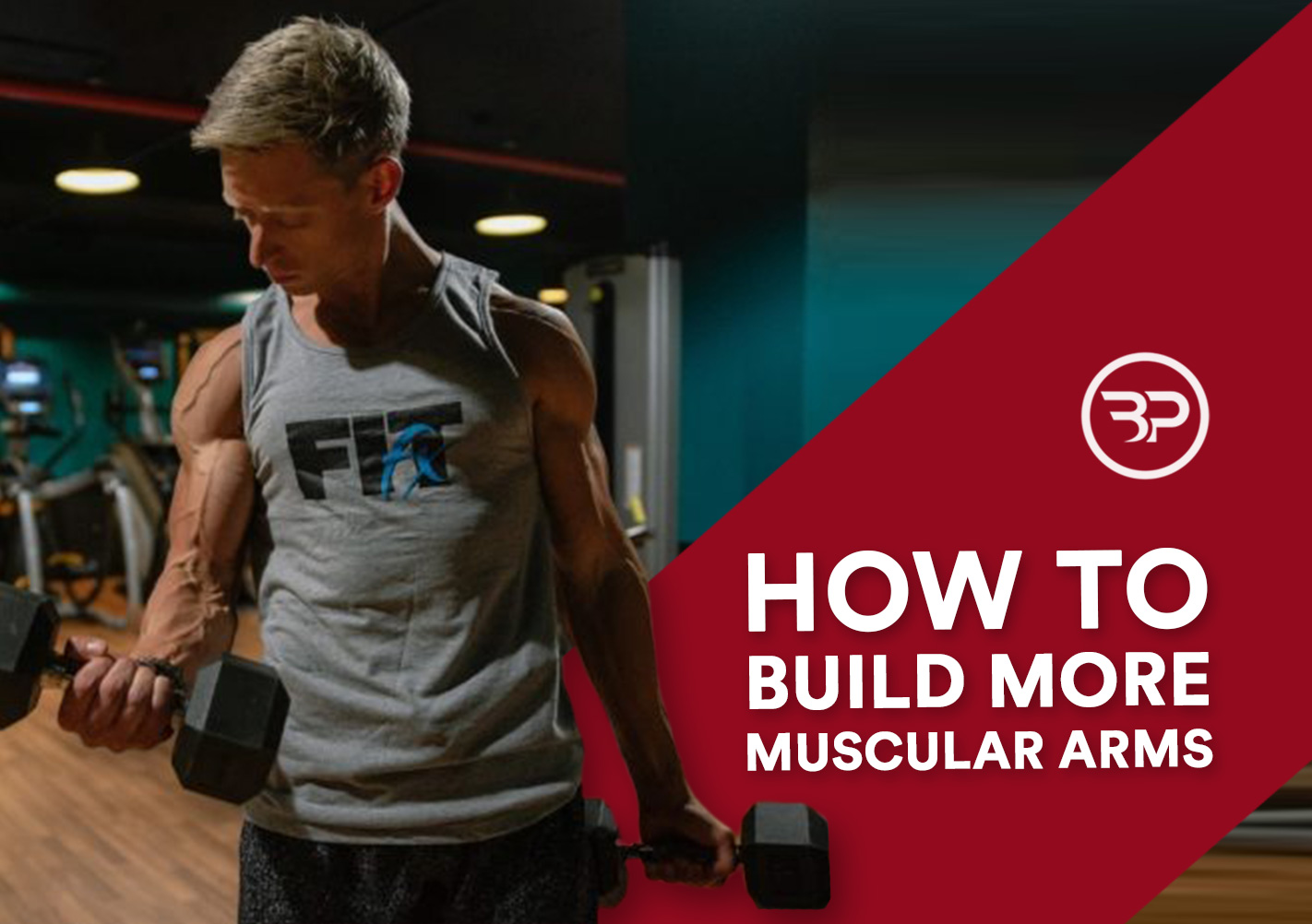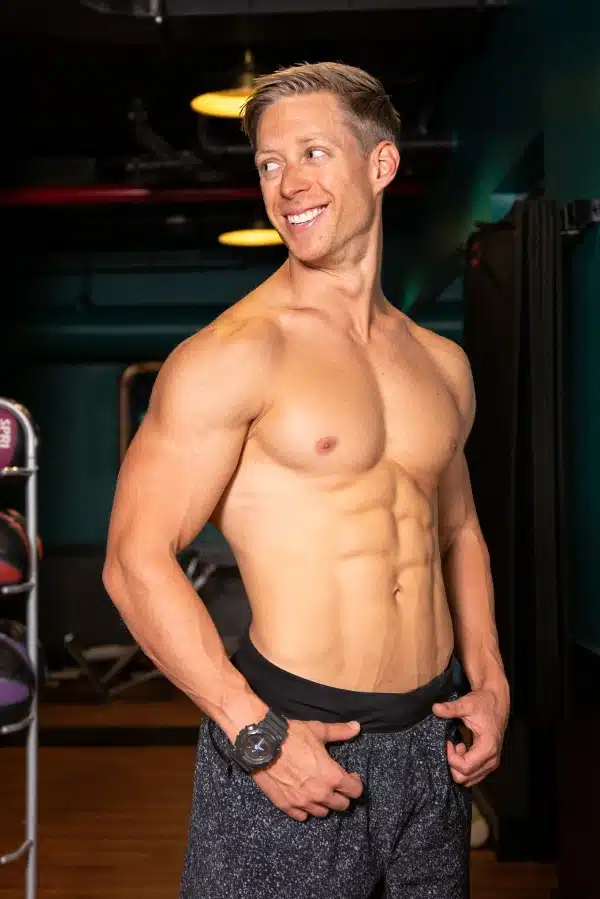How To Build More Muscular Arms
November 13, 2018
Here are 9 tips to build more muscular arms. To sweeten the pot, I’m also giving you the best 10 exercises and a workout to get started.
99 percent of men want more muscular arms. The other one percent? They’re lying.
Okay, I’m half kidding. But there’s no denying men want big, veiny, triumphant biceps to stretch shirt sleeves. It’s an alpha male display of strength, power, and authority.
But how do you get there? Cracking the code can be tough. Some coaches say all you need is to get bigger as a whole with squats, deadlifts, and a steady dose of chin-ups and rows. Others say you need to pound those pencil thin fuckers into oblivion until they grow.
So, what’s the answer? Well, I hate to say it, but they’re both right and both wrong. Here are 9 tips to build more muscular arms. Then it’s on to the best exercises and workouts to do just that.
 Tip #1 – Train For The Pump
Tip #1 – Train For The Pump
Metabolic stress, aka the pump, is a necessary component to building muscle. The sweet spot for building muscle is a moderate weight for 8-12 reps. This combines both tension and metabolic stress. Then sprinkle in even higher rep sets – 15 or more reps. Go to complete muscular failure occasionally to blitz every muscle fiber possible. Add unfamiliar exercises or training methods to your workouts. The goal is moderate muscular damage, not a full-out obliteration of your arms that leaves you unable to open your car door.
Tip #2 – Use Brutally Effective Compound Sets
Compound sets (not to be confused with supersets, which train opposing muscle groups) pair two exercises that train the same muscles back-to-back without rest between them. They’re fucking brutal for two reasons.
First, they create an insane amount of muscle-building metabolic stress.
Second, they fatigue every last muscle previously untapped muscle fiber. Compound sets can be incredibly effective muscle builders, but your recovery must be up to par.
Here’s one of my favorite from coaching legend Charles Poliquin:
- Close-grip Chin-up 6-8 reps
- Incline Dumbbell Biceps Curl 10-12 reps
- Rest 60 seconds and repeat twice more
 Tip #3 – Build Strength To Create Muscle Building Mechanical Tension
Tip #3 – Build Strength To Create Muscle Building Mechanical Tension
This is achieved by using substantial weight and performing exercises through a full range of motion for a certain amount of time. The time you spend under tension (TUT) creates mechanical tension in the muscles, which triggers muscle growth.
To take advantage of mechanical tension you need a foundation of strength. Being strong makes high-rep pump work more effective because you can use a heavier for more weight, creating a bigger training response. Here are a few strength baselines to shoot for:
- Bench Press: 1.5 x bodyweight
- Squat: 2 x bodyweight or front squat 1.75 x bodyweight
- Deadlift: 2 x bodyweight
- Pull-Up: 12 reps, full range of motion. (This will help you access your relative strength.)
Hammer the close-grip bench presses, dips, ring dips, and overhead presses for your triceps. Keep your close grip at about 14 inches or wider to avoid too much stress on your wrists and elbows.
For your biceps/brachialis, build strength on all chin up and rowing exercises.
Tip #4 – Row Every Day
Adding a row or horizontal pull to each workout is paramount to keeping your shoulders healthy and combating the caveman posture induced by our obsession with smartphones.
A cool benefit of rowing every day is a thicker back and yes, frozen ropes for forearms and thick biceps. As I mentioned before, grip variety is important. Incorporate different types of rows and hand positions. Because you’re training rows frequently, keep the volume on each day low to prevent overuse.
Tip #5 – Understand Armed and Dangerous Anatomy
I admit it: I buried the anatomy lesson because I didn’t want to bore you to tears. But if you want to get jacked, this shit is important.
Your upper arms are primarily composed of your biceps, triceps, and to a lesser extent, your brachialis. Your biceps have two heads, the long head, and short head. Different grips will stimulate each head differently. Any pulling exercise (pull up, row) will train your biceps.
Your brachialis shows up underneath your biceps, pushing your bi’s up and giving your arms a more well-rounded look. You’ll train these bad boys whenever using a neutral or “thumbs up” grip.
Your triceps are composed of three muscles; hence “tri”.
Long Head: The biggest of the triceps muscles, the long head responds well to the seated EZ-bar French press.
Lateral Head: The lateral head is hit hardest with movements where your arms are by your sides, such as triceps pushdowns or dips.
Medial Head: The medial head receives stimulation in most triceps exercises. Still, you can emphasize the medial head by using a supinated (palms up) grip, such as a supinated-grip triceps pushdown.
Why All This Matters:
Any pushing exercise (push-ups, bench press) will train your triceps. Overall, your triceps make up about 75% of your arm girth. So spend more time training your triceps.
 Tip #6 – Vary Your Grips To Keep Your Joints Health
Tip #6 – Vary Your Grips To Keep Your Joints Health
Sticking to the same grip from workout to workout, month after month is a first class ticket to your physical therapist for wrist, elbow, and shoulder pain.
You need to switch up your hand positions and grips to avoid overuse injuries while simultaneously maximizing muscle fiber recruitment. Here’s a quick overview of different hand positions and how they’ll affect your training response.
Wider Grip:
A wide grip, considered beyond 2 inches from shoulder width, hits the short head (inner portion) of your biceps a bit more. The short head works harder with the arms in front of the body, like a preacher curl. On bench presses, a wide grip shortens the range of motion and may decrease the role of your triceps.
Narrow Grip:
A narrow grip, anything inside shoulder width, hits the long head of the biceps harder. The long head is the primary supinator, responsible for rotating your palms away from you, and the key to developing a biceps peak. Incline dumbbell curls work well because the elbows drift behind the body and put the long head under maximum stretch. A narrow grip on pressing exercises will increase the range of motion of the lift, calling the triceps into play. Don’t go too narrow, though or your elbows and wrists will pay the price. A grip right around shoulder width or about 14 inches is as narrow as you need to go.
Shoulder Width Grip:
The old standard, a shoulder width grip tends to hit muscle fibers fairly evenly.
Neutral Grip:
A neutral grip (thumbs up, palms facing one another) will hammer the brachialis, which sits underneath the bicep and adds thickness to the arm. Exercises like a hammer curl or pinwheel curl (cross body hammer) with slower tempo work well. On pushing exercises, a neutral grip is generally easier on your shoulders, which can allow you to increase training volume without shoulder pain.
Pronated Grip:
In regular speak, the overhand grip. This hammers your forearms to a greater degree.
Tip #8 – Control The Eccentric (Negative)
We’ve all seen the guy bangin’ out swayback curls and hoisting more weight than he can handle. Unfortunately, this is a recipe for failure. When training your arms, your goal is to maximize your mind-muscle connection, get a pump, and train the muscles, not set gym personal records.
Specifically, on isolation exercises, take 3-5 seconds during the “down” phase to stretch your muscles. Pause at the peak contraction of each rep, and feel your muscles during the work.
If you have trouble feeling a muscle it won’t grow. Controlling the negative on yours lifts will enhance your mind-muscle connection, boosting growth. Even better, you’ll keep muscles under constant tension and train the harder without beating the snot out of your joints.
 Tip #9 – Add More Variety
Tip #9 – Add More Variety
While trying to “confuse” your muscles is generally a terrible idea, it is good to occasionally mix and match training methods for your arms. Far too many lifters throw in three sets of curls on Friday before calling it a week, then end up frustrated they can’t grow.
So picking an intensity boosting method can spice up your routine and lead to new growth. Here are two options.
1. Isometrics:
When it comes to hypertrophy, isometrics recruit the largest motor units and improve neural drive, helping you feel maximum tension in the muscle. Not only will this improve strength at the angle trained during the isometric hold, but it’ll improve your mind-muscle connection based on maximum voluntary contraction.
2. Drop Sets
Drop sets work by first recruiting as many muscle fibers as possible, then blasting them with volume until they swell up. You’re left with an enormous pump and the stimulation needed to grow. After a heavier set, drop the weight by 20-30% and do as many reps as possible. If you’re a masochist, drop the weight another 20-30% and rep out again.
In both cases, stick with a method and movement for 3-4 weeks before changing it out. I know this sounds complicated and like a lot of work, so let me help you. Inside the BOSS group coaching community you’ll have an entire crew of training partners to keep you consistent, and motivated. Even better, I’ll coach you through your workouts and provide the expert plans you need to build big arms, fast.
Join today and begin your big arm blueprint.

Best Exercises For Muscular Arms
Biceps
Chin Ups
Chin ups on a straight bar or rings are the most effective exercise to build big biceps. Train chin-ups like you would any strength movement and add weight as you improve. Chin-ups will create a ton of mechanical tension within your biceps, not to mention your lats for rapid growth.
In the video below I’m using a straight bar, but rings are an even better option. They’ll allow a free range of motion for your wrists, elbows, and shoulders to prevent injuries.
Try 4×5-8 reps, increasing the weight on each set.
Good Old Dumbbell Curls: Dumbbell curls allow for a free range of motion and are more joint-friendly than barbell curls. When doing dumbbell curls, leave your ego at the door. Take 3-5 seconds down, allowing your biceps to fill with blood before flexing hard at the top of each movement.
Incline Curl:
Incline dumbbell curls build the vaunted biceps peak better than any other exercise. Because your elbows drift behind your body, your biceps are placed under an incredible stretch. For this reason, you’ll need to go light with a slow tempo. Don’t worry, the pain will be worth it when your sleeves start hugging your biceps.
Isodynamic contrast curls
Isodynamic contrast curls are my favorite “shock” method for the biceps.
Pick a weight you could curl for 15 reps.
Curl the weight to the common sticking point, right around 90 degrees of flexion. Squeeze the dumbbells as hard as possible to create an irradiation stimulus and improve muscle fiber recruitment. Hold that squeeze for 15-20 seconds.
After the hold, perform curls for 8-12 reps, or to technical failure. This creates tons of metabolic stress, mechanical tension, and improves the mind-muscle connection to build bigger, stronger biceps. Do three to four sets twice a week.
Brachialis
Pinwheel curls
Pinwheel curls, a “cheat” version of hammer curls allow you to use more weight, taking advantage of an eccentric overload. Because your body is stronger during the eccentric (lowering) portion of a lift, using a slight cheat on exercises like this curl allow you to slow the tempo down and create more overall tension in the muscle than classic hammer curls. Try 3×8-10 heavy reps.
Triceps
Ring Dips:
I could have gone with the close grip bench press here but let’s be real: you spend plenty of time on the bench press. Ring dips are an incredible exercise because they require another level of stability through your wrist, elbow, and shoulder. You’ll recruit a ton of dormant muscle fibers and add meat to your triceps, fast.
Skull crushers: Skullcrushers are an old stand-by and incredibly effective arm builder. The problem with most of them? They light your elbows up like the 4th of July. In this case, I prefer dumbbell skull crushers because they’re easier on your joints yet incredibly effective in building the long and lateral heads of your triceps.
Overhead Split Extension
The cable overhead split extension is my favorite joint-friendly triceps builder. Due to the overhead position, you place the triceps under tension throughout the lift. Use a slow tempo and allow your elbows to drift back slightly on each rep, before pausing at peak contraction.
Pre-set Isohold Triceps Pushdown
The iso-hold will improve your mind muscle connection to bring up lagging body parts. In this pushdown, Perform a triceps extension with a rope attachment and pull the ends apart while flexing your triceps as hard as possible for 15 seconds. Then, move directly into your triceps push down. Try 4×10-12 reps with a 15 second isometric to help those mofo’s grow.
Reverse Grip Triceps Pushdown:
The reverse grip triceps pushdown is a good change of pace lift to focus on the medial head of your triceps. The reverse grip forces you to go lighter, which opens the door for you to slow down flex, and feel your triceps contracting. Mix reverse grip triceps pushdowns in with higher reps, like 3×20 at the end of a workout.
The Muscular Arms Workout
Since your arms get trained on all pushing and pulling exercise, keep your dedicated arm day to once per week.
1a. Ring Chin Up 4×6, rest 60-90s
1b. Ring Dip 4×6, rest 60-90s
2a. Neutral grip dumbbell bench press 3×12, rest 45s
2b. Supinated grip dumbbell bent over row 3×12, rest 45s
3. Cable Triceps Pushdown 3×15, rest 45-60s
Notes: Dynamic Isohold method
4. Dumbbell Pinwheel curl 3×8, rest 60s
5a. Incline Dumbbell Curl 3×15, rest 0-15s
5b. Close Grip Push Up 3×15, rest 0-15s
5c. Incline Dumbbell Skull Crushers 3×15, rest 0-15s









I will try these and see what results I get.